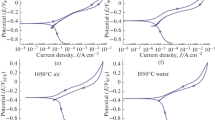Abstract
In oil and gas production environments, H2S and Cl− can coordinate to cause pitting or stress corrosion cracking (SCC) of stainless steels. There has been limited work conducted on corrosion and SCC of autenitic stainless steels in high H2S–CO2–Cl− environments. In this paper, by four-point bending test method and scanning electron microscopy analysis, SCC of 316L steel was investigated under high H2S–CO2 pressures with 150,000 ppm Cl− at 60 °C. The effect of high H2S–CO2 pressure was discussed. The results indicated that the higher H2S–CO2 pressure can accelerate anodic dissolution process, deteriorate passive films, and aggravate SCC sensitivity. Using cyclic potentiodynamic polarization measurements, the corrosion behavior of 316L steel was studied in high H2S–CO2–Cl− environments. The effect of pH on pitting corrosion was discussed. Lower pH can promote both cathodic and anodic actions on 316L steel and facilitate passive film breakdown.









Similar content being viewed by others
References
Daryoush Masouri, Mahmoud Zafari et al (2008) In: Corrosion/2008, Paper No. 08480, NACE, Houston
Al-Sulaiman S, Al-Mithin A et al (2010) In: Corrosion/2010, Paper No. 10176, NACE, Houston
Abelev E, Sellberg J, Ramanarayanan TA et al (2009) J Mater Sci 44:6167–6181. doi:10.1007/s10853-009-3854-4
Fierro G, Ingo GM, Mancia F et al (1990) J Mater Sci 25:1407–1415
Klower J, Schlerkmann H et al (2001) In: Corrosion/2001, Paper No. 01004, NACE, Houston
Ardjan Kopliku, Matthew Tabinor et al (2009) In: Corrosion/2009, Paper No. 09082, NACE, Houston
Elizabeth Trillo, Russell D. Kane et al (2006) In: Corrosion/2006, Paper No. 06156, NACE, Houston
Liu ZY, Dong CF, Li XG et al (2009) J Mater Sci 44:4228–4234. doi:10.1007/s10853-009-3520-x
Joia CJBM, Small ALLT et al (1997) In: Corrosion/1997, Paper No. 97048, NACE, Houston
Rongguang Wang, Yun Wei, Qinglian Zhang et al (2000) J Chin Soc Corr Protect 20(1):47–53 (in Chinese)
Zuo Yu, Shuxia Zhang (1994) J Bei**g Inst Chem Technol 21(4):58–64 (in Chinese)
Zhiyong Liu, Chaofang Dong, **aogang Li et al (2009) J Univ Sci Technol Bei**g 31(3):318–323 (in Chinese)
Yaofeng Zhang, Ding Yi, **aofeng Lu et al (2007) J Chin Soc Corr Protect 27(2):101–108 (in Chinese)
**ao Jimei (2006) The metallography problems of stainless steel. Metallurgical Industry Press, Bei**g (in Chinese)
Mercer AD, Mas R, Kreysa G (eds) (2002) European Federation of Corrosion Publication No. 17. Corrosion resistant alloys for oil and gas production: Guidance on general requirements and test methods for H2S service, 2nd edn. Maney Publishing
International standard (2009) Petroleum and natural gas industries—Materials for use in H2S-containing environments in oil and gas production, 2nd edn. ANSI/NACE MR0175/ISO 15156-2:2009(E)
Chinese national standard (2000) Corrosion of metals and alloys-Stress corrosion testing-Part 2: Preparation and use of bent-beam specimens. GB T 15970.2
NACE Standard RP-0775 (2005) Preparation, Installation, Analysis, and Interpretation of Corrosion Coupons in Oilfield Operations. NACE International
Chinese national standard (1999) Method of pitting potential measurement for stainless steels, GB T 15970.2
Ikeda, Mukai S, Ueda M (1985) Corrosion 41(4):185–192
Al-Mansour M, Alfantazi AM, Eo-boujdaini M (2009) Mater Des 30:4088–4094
John Sedriks A (1996) Corrosion of stainless steel, 2nd edn. John Wiley and Sons Inc, New York
Cheng YF (2007) J Mater Sci 42:2701–2705. doi:10.1007/s10853-006-1375-y
Speidel MarkusO (1981) Metall Trans A 12A(5):779–789
Acknowledgements
This work is supported by National Natural Science Foundation of China (Grant NO. 50971017 and Grant NO. 51171022).
Author information
Authors and Affiliations
Corresponding author
Rights and permissions
About this article
Cite this article
Ding, J., Zhang, L., Li, D. et al. Corrosion and stress corrosion cracking behavior of 316L austenitic stainless steel in high H2S–CO2–Cl− environment. J Mater Sci 48, 3708–3715 (2013). https://doi.org/10.1007/s10853-013-7168-1
Received:
Accepted:
Published:
Issue Date:
DOI: https://doi.org/10.1007/s10853-013-7168-1



